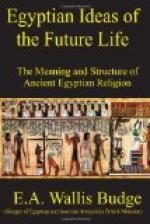But besides the nine gods who were supposed to form the “great company” of gods of the city of Heliopolis, there was a second group of nine gods called the “little company” of the gods, and yet a third group of nine gods, which formed the least company. Now although the paut or company of nine gods might be expected to contain nine always, this was not the case, and the number nine thus applied is sometimes misleading. There are several passages extant in texts in which the gods of a paut are enumerated, but the total number is sometimes ten and sometimes eleven. This fact is easily explained when we remember that the Egyptians deified the various forms or aspects of a god, or the various phases in his life. Thus the setting sun, called Temu or Atmu, and the rising sun, called Khepera, and the mid-day sun, called R[=a], were three forms of the same god; and if any one of these three forms was included in a paut or company of nine gods, the other two forms were also included by implication, even though the paut then contained eleven, instead of nine gods. Similarly, the various forms of each god or goddess of the paut were understood to be included in it, however large the total number of gods might become. We are not, therefore, to imagine that the three companies of the gods were limited in number to 9 x 3, or twenty-seven, even though the symbol for god be given twenty-seven times in the texts.
We have already alluded to the great number of gods who were known to the Egyptians, but it will be readily imagined that it was only those who were thought to deal with man’s destiny, here and hereafter, who obtained the worship and reverence of the people of Egypt. These were, comparatively, limited in number, and in fact may be said to consist of the members of the great company of the gods of Heliopolis, that is to say, of the gods who belonged to the cycle of Osiris. These may be briefly described as follows:—




